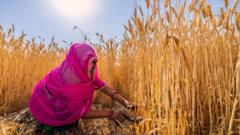The rise of an early summer has sparked concerns for India’s agriculture and industry this season. Nitin Goel, who has run a clothing business in Ludhiana for 50 years, is facing a challenge as winter clothing sales plummet. “With winter getting shorter, we’re now making t-shirts instead of sweaters,” he explained. The Indian Meteorological Department confirmed last February was the hottest in 125 years, with temperatures unusually high across much of the nation.
Retailers hesitated to purchase even confirmed clothing orders due to the soaring heat, further straining small businesses like Goel's. As a result, he had to adapt to a "sale or return" approach where unsold goods are returned, placing the financial burden on him. Other businesses have shut down due to these market conditions.
Meanwhile, on India's western coast, farmers like Vidyadhar Joshi are grappling with heat impacting mango orchards. “Production will only be around 30% of normal," he lamented, attributing the losses to increased irrigation costs and labor shortages. This trend isn't isolated, as wheat and other staples are also threatened by extreme temperatures.
While the Indian agriculture minister remains optimistic about wheat yield, experts warn the situation could mirror 2022's yield losses of up to 25%. Furthermore, decreasing reservoir levels in northern India raise concerns for water availability in farming sectors. This situation risks rising inflation and overall economic growth setbacks.
Recent analysis reveals that three out of four Indian districts are now "extreme event hotspots," underlining the urgent need for improved weather forecasting, adaptive agricultural practices, and stronger infrastructure to combat climate-related challenges. As India grapples with these issues, the focus remains on protecting both lives and the economy from the impacts of climate change.






















